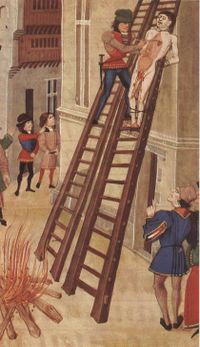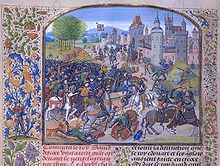- Froissart's Chronicles
-
 The execution of Hugh the younger Despenser, A miniature from one of the most famous manuscripts of the Chronicles.
The execution of Hugh the younger Despenser, A miniature from one of the most famous manuscripts of the Chronicles.
Froissart's Chronicles was written in French by Jean Froissart. It covers the years 1322 until 1400 and describes the conditions that created the Hundred Years' War and the first fifty years of the conflict. For centuries it has been recognized as the chief expression of the chivalric revival of fourteenth-century England and France.
Contents
Inspiration and creation of Froissart's Chronicles
Jean Froissart was an eye-witness to the events of the Siege of Paris. Although it seems Froissart never saw battle, he did visit Sluys in 1386 to see the preparations for an invasion of England. The invasion was ultimately aborted. However, he was present at other significant events such as the baptism of Richard II.
Froissart first wrote a rhyming chronicle for Philippa of Hainault that is now lost. He began Book I of the surviving chronicle in 1369 at the insistence of Robert de Namur. He finished it in 1373; his own experiences, combined with those of interviewed witnesses, supply much of the detail.
The other important source for the early part of the chronicle was the Vrayes Chroniques of Jean Le Bel, of which Froissart directly copied large parts. Le Bel wrote his chronicle for Jean, lord of Beaumont; and Jean's grandson, Guy II, Count of Blois. He later became the patron of Book II of Froissart's Chronicles. This second volume of Froissart's Chronicles was completed in 1388 and is entirely Froissart's work. Book III was completed in 1390 and Book IV in 1400.Historical events included in the Chronicles
Some of the important events recorded in Froissart's Chronicles:
Book I 1322–1377
- Edward II deposed and accession of Edward III
- Execution of Hugh the younger Despenser
- Battle of Sluys
- Battle of Crécy
- The Siege of Calais
- Battle of Neville's Cross
- The founding of the Order of the Garter
- The Black Death
- Battle of Les Espagnols sur Mer, a sea battle off Winchelsea
- Battle of Poitiers
- Étienne Marcel leads a merchant revolt in Paris
- The Jacquerie
- The Death of King John II of France
- The end of Edward III reign
Book II 1376–1385
- The Great Schism
- The Peasants' Revolt
- The Battle of Roosebeke
- The marriage of Charles VI to Isabella of Bavaria
Book III 1386–1388
- The French preparations for an aborted invasion of England
- The final trial by combat ordered by French courts between Jean de Carrouges and Jacques Le Gris
- Richard II in conflict with his uncles
- The Battle of Otterburn
Book IV 1389–1400
- A festival in honor of Isabeau of Bavaria
- A tournament in Smithfield held by Richard II
- The death of Gaston III of Foix-Béarn
- The madness of Charles VI
- Richard II deposed and accession of Henry IV
- Battle of Nicopol and massacre of the prisoners
Modern reception and criticisms
Froissart's work is perceived as being of vital importance to modern understanding of 14th century events. However, modern historians also recognize that his Chronicles betray many shortcomings: erroneous dates, misplaced geography, inaccurate estimations of casualties, and biases in favor of his patrons. He also omits information about the common people of the time. Sir Walter Scott once remarked that Froissart had "marvelous little sympathy" for the "villain churls."
The Chronicles are almost 3 million words long, yet few complete editions are published. Froissart is often repetitive or covers insignificant subjects. Nevertheless, his battle descriptions are lively and engaging; he provides a wealth of information for the social historian. Enguerrand de Monstrelet continued the chronicle to 1440.
The text of Froissart's Chronicles is preserved in more than 100 manuscripts which are illustrated by a variety of miniaturists. One of the most lavishly illuminated copies was commissioned by Louis of Gruuthuse, a Flemish nobleman, in the 1470s. The four volumes of this copy (BNF, Fr 2643-6) contain 112 miniatures painted by the best Brugeois artists of the day. Among them is Loiset Lyédet, to whom the miniatures in the first two volumes are attributed. The illustrations here come from this copy.
External links and literature
- Jean Froissart, Chronicles, Penguin Classics, 1978 ISBN 0-14-044200-6 (at close to 500 pages even this is only an excerpt).
- Chronicles of England France, Spain, etc.' Continuing project to web the entirety of the 1805 Thomas Johnes translation. Currently 95 chapters online, new chapter(s) added weekly, Monday updates.
- Tales from Froissart excerpts from 1849 edition of the Thomas Johnes translation (1805).
- The Chronicles of Froissart excerpts from John Bourchier and Lord Berners 1910 Harvard Classics translation.
- An extensive bibliography collected by Dr Godfried Croenen
- Full edition of Froissart's Chronicles in 12 volumes, translated by Thomas Johnes
Categories:- 14th-century history books
- Chronicles
- French non-fiction literature
- French chronicles
- Hundred Years' War literature
Wikimedia Foundation. 2010.


